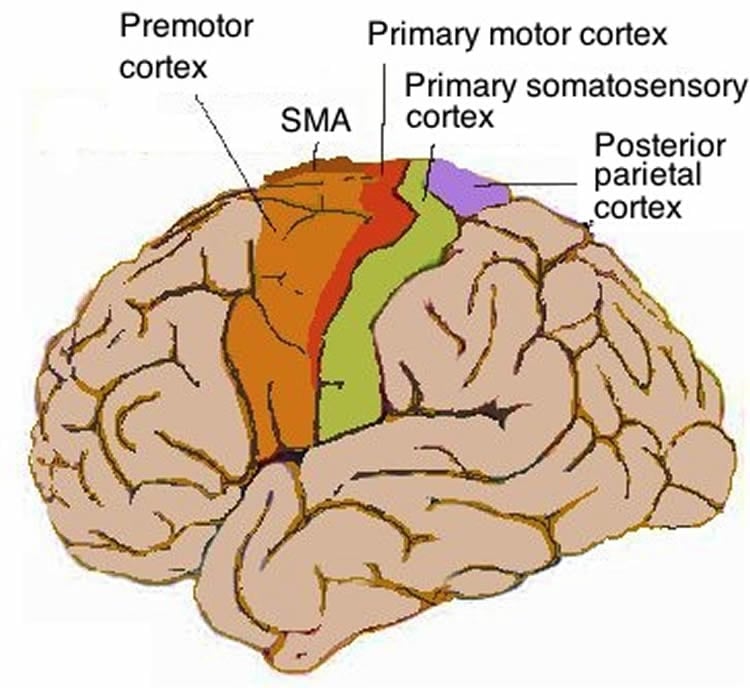Summary: Comprehension of words relies on areas of the brain associated with motor control as well as ‘classic’ language centers, researchers report.
Source: National Research University Higher School of Economics.
Researchers from HSE, Northumbria University, and Aarhus University have experimentally confirmed the hypothesis, whereby comprehension of a word’s meaning involves not only the ‘classic’ language brain centres but also the cortical regions responsible for the control of body muscles, such as hand movements. The resulting brain representations are, therefore, distributed across a network of locations involving both areas specialised for language processing and those responsible for the control of the associated action. The results have been published in the journal Neuropsychologia.
One of the basic issues related to the nature of human cognition is the question about the correspondence between physical experiences and feelings, on one hand, and the nature of the brain representations of words and sentences describing these experiences, on the other.
Traditional modular views of cognition suggest that, to encode and comprehend the meaning of a word such as ‘throw’, the brain’s “language module” does not to involve any structures related to the meaning per se (i.e. the “motor module” responsible for the associated movements programs such as the arm and hand movements involved in the act of throwing.
An alternative is offered by an embodied or distributed view suggesting that the brain areas encoding the meaning of a word include both the areas specialised for representing linguistic information, such as the word’s acoustic form, but also those brain areas that are responsible for the control of the corresponding perception or action. On this account, in order to fully comprehend the meaning of the word ‘throw’, the brain needs to activate the cortical areas related to hand movement control. The representation of the word’s meaning is, therefore, ‘distributed’ across several brain areas, some of which reflect experiential or physical aspects of its meaning.
A team of researchers from Denmark, England, and Russia (Nikola Vukovic, Matteo Feurra, Anna Shpektor, Andriy Myachykov, and Yury Shtyrov) investigated the nature and the mechanisms of such distributed word representations. They carried out a series of experiments aiming at finding out how stimulating motor cortex using transcranial magnetic stimulation (TMS) affects word comprehension.
28 volunteers took part in these experiments. A TMS magnetic pulse was delivered to the areas in motor cortex responsible for hand movements as participants engaged in one of the two computer-based experimental tasks: detecting whether a presented string of letters is a word or not, and choosing whether the presented stimulus relates to an abstract or a concrete action.

‘We used TMS to inhibit neural activity in the motor cortex as participants tried to distinguish between words related or unrelated to hand movements,’ says Andriy Myachykov, leading Research Fellow at the HSE Centre for Cognition & Decision Making and a Senior Lecturer at Northumbria University, Newcastle-upon-Tyne. He notes: ‘The advantage of TMS methodology is that it allows to establish the causal link between the stimulated brain area and the cognitive function or behaviour it’s hypothesised to support. This distinguishes TMS from many other existing neuroimaging methods. If motor programmes are directly involved during the comprehension of action words, then suppressing neural activity in hand-related motor cortex would interfere with word processing but only if the word also denotes hand movement. Namely, this should lead to increase in task performance errors and longer reaction times. This is exactly what we found’.
These new findings suggest that language-specialised brain areas work in constant interaction with other areas known to support other cognitive processes, such as perception and action. The resulting distributed meaning representations act as dynamic cortical networks rather than a series of specialised modules as suggested by traditional theories.
Source: National Research University Higher School of Economics
Image Source: NeuroscienceNews.com image is credited to Pancrat and is licensed CC BY SA 3.0.
Original Research: Abstract for “Primary motor cortex functionally contributes to language comprehension: An online rTMS study” by Nikola Vukovic, Matteo Feurra, Anna Shpektor, Andriy Myachykov, and Yury Shtyrov in Neuropsychologia. Published online January 22 2017 doi:10.1016/j.neuropsychologia.2017.01.025
[cbtabs][cbtab title=”MLA”]National Research University Higher School of Economics “Motor Cortex Contributes to Word Comprehension.” NeuroscienceNews. NeuroscienceNews, 15 February 2017.
<https://neurosciencenews.com/word-comprehension-motor-cortex-6118/>.[/cbtab][cbtab title=”APA”]National Research University Higher School of Economics (2017, February 15). Motor Cortex Contributes to Word Comprehension. NeuroscienceNew. Retrieved February 15, 2017 from https://neurosciencenews.com/word-comprehension-motor-cortex-6118/[/cbtab][cbtab title=”Chicago”]National Research University Higher School of Economics “Motor Cortex Contributes to Word Comprehension.” https://neurosciencenews.com/word-comprehension-motor-cortex-6118/ (accessed February 15, 2017).[/cbtab][/cbtabs]
Abstract
Primary motor cortex functionally contributes to language comprehension: An online rTMS study
Among various questions pertinent to grounding human cognitive functions in a neurobiological substrate, the association between language and motor brain structures is a particularly debated one in neuroscience and psychology. While many studies support a broadly distributed model of language and semantics grounded, among other things, in the general modality-specific systems, theories disagree as to whether motor and sensory cortex activity observed during language processing is functional or epiphenomenal. Here, we assessed the role of motor areas in linguistic processing by investigating the responses of 28 healthy volunteers to different word types in semantic and lexical decision tasks, following repetitive transcranial magnetic stimulation (rTMS) of primary motor cortex. We found that early rTMS (delivered within 200 ms of word onset) produces a left-lateralised and meaning-specific change in reaction speed, slowing down behavioural responses to action-related words, and facilitating abstract words – an effect present only during semantic, but not lexical, decision. We interpret these data in light of action-perception theory of language, bolstering the claim that motor cortical areas play a functional role in language comprehension.
“Primary motor cortex functionally contributes to language comprehension: An online rTMS study” by Nikola Vukovic, Matteo Feurra, Anna Shpektor, Andriy Myachykov, and Yury Shtyrov in Neuropsychologia. Published online January 22 2017 doi:10.1016/j.neuropsychologia.2017.01.025







